‘One of the most classic racing engines of all time – and unquestionably the most widely copied – was the 1913 3-litre four cylinder Peugeot conceived jointly by Georges Boillot, Jules Goux and Paolo Zuccarelli whose ideas were interpreted by the brilliant draftsman Ernest Henry’ ; Harry Mundy in Automobile Year #10…
The team first expounded the advantages of twin overhead camshafts, four valves per cylinder and compact combustion chambers.
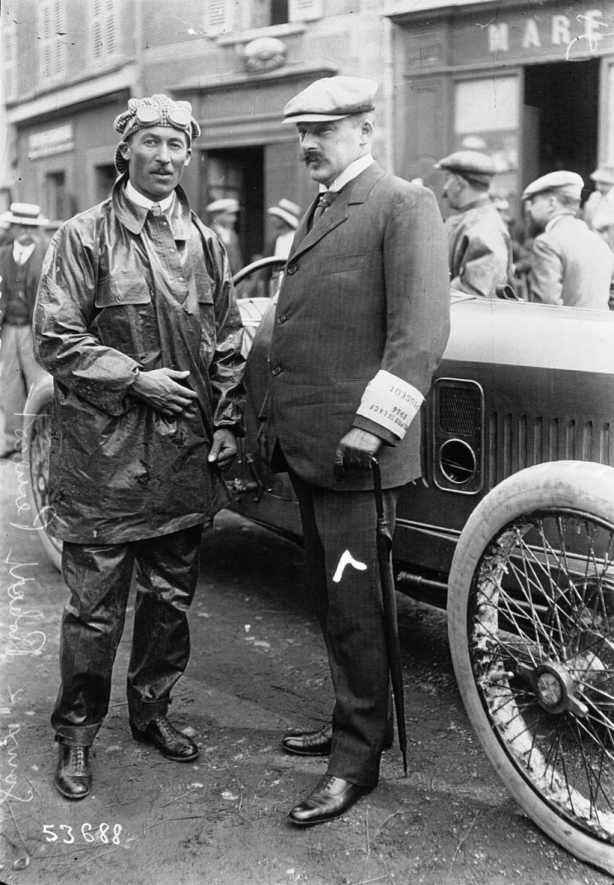
Jules Goux fourth and Robert Peugeot at the 1914 French GP. Goux winner at Indy in 1913 in a Peugeot L56. Mercedes Christian Lautenschlager won the race, Boillot was well in the lead before a spate of Dunlop tyre problems. 4 July 1914, less than a week after the assassination of Archduke Franz Ferdinand and the imminent start of WW1 (unattributed)
‘The Three Charlatans’; driver/technicians Goux, Boillot and Zuccarelli, the latter the most important in terms of his conceptual ideas, as they became known within Peugeot HQ, put a proposal to M Robert Peugeot to develop, outside the factory a team of cars for the 1912 French GP. The race was being revived that year, and two 3-litre cars for the Coup l’Auto at a cost of 4000 pounds for each car.
The 1912 GP engine of 7602cc was estimated to develop 140bhp@2200rpm, the car very successful as covered in the contemporary magazine articles included at the end of this piece.
‘Overhead camshafts had been used earlier by Mercedes and Clement-Bayard…The technical contribution of the Peugeot engine was in the use of the hemispherical combustion chamber, four valves per cylinder operated directly by twin overhead camshafts and a central sparking plug. In other words, Zuccarelli, from whom this conception emanated, appreciated the virtues of a compact combustion chamber, large effective valve area and low valve stresses’.
‘A stirrup-type valve tappet guided top and bottom ad having its own return spring was used and the entire mechanism was fully enclosed and lubricated; the valves and springs were exposed to assist cooling…The one piece cylinder block and head was bolted to a two piece crankcase split on the horizontal centre line of the five main bearings’ said Mundy.
Boillot won the 1912 French GP at Dieppe by 13 minutes from the closest Fiat at an average speed of 68.5 mph. The Fiats, to demonstrate the efficiency of the Peugeot engine were of 14143cc.
The 3-litre Peugeot engine produced for the 1913 Coupe de l’Auto race run concurrently with the French GP, was the more important in its technical influence as its efficiency and light chassis was more than a match for the 1912/13 GP cars built for an unlimited formula and having in some cases twice the capacity.
Many features of the 3-litre were common with its bigger brother but other key elements copiously copied were;
.A train of spur gears contained in a separate and easily detachable casing which replaced the former bevel gear and shaft drive to the camshafts
.The heavy stirrup type of valve tappet was discarded in favour of a finger interposed between the cam and valve stem
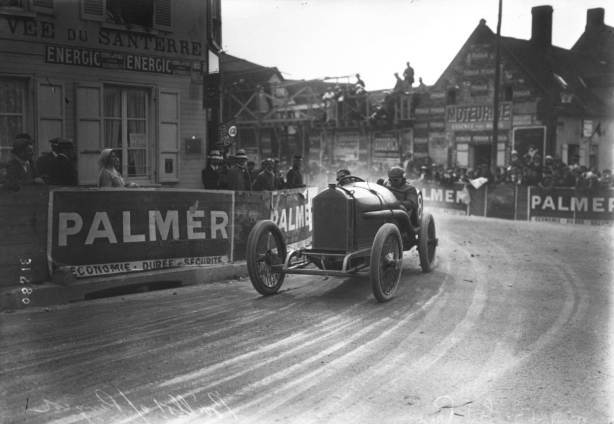
Boillot on the way to Peugeot L3 victory on the Amiens 31.6 km road course used only once for the French GP, in 1913. Zuccarelli was killed when he hit a cart before the race; five fatalities at the place in two months (unattributed)
.A novel construction was introduced for the crankcase and the three main bearing crank, made of the highest quality BND/Derihon steel. The latter was made in two halves and bolted at the centre, at which point a double row ball bearing was used; a single row roller bearing was used for the front and rear mains. This type of construction permitted the use of a one-piece crankcase casting, the two end bearings for the crankshaft being contained in a separate housing.
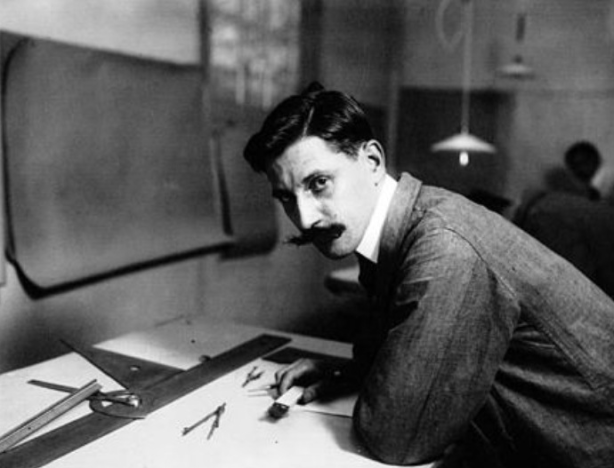
Ernest Henry at his drawing board, year unknown. Hiss exact contribution to the design of the Peugeot’s and the engine still the subject of debate after 100 years; a key member of the team whichever way you cut it (unattributed)
.It was also the first engine to use dry-sump lubrication; better cooling with full pressurisation to all bearings and also allowing engines to be placed lower in the chassis.
The influence of the engine was also profound in the sense that it lead to the adoption of a capacity limitation from 1914, a principle adopted for most subsequent formulae. From 1914 onwards there was no effective alternative to the overhead camshaft as stroke to bore ratios were reduced and rotational speeds increased, two basic requirements of increased performance…
Contemporary ‘The Automobile’ articles on the 1912/1913 Peugeots…
1912 L76 7.6-litre.
1913 L3 3-litre.
Bibliography and Credits…
Automobile Year #10 article by Harry Mundy on Grand Prix engines, ‘The Automobile’ 26 September 1912 and February 1914 articles via theoldmotor.com, The Nostalgia Forum Peugeot GP thread, Jacques Henri-Lartigue
Tailpiece: Boillot, winner on Peugeot L3. French GP, Amiens 12 July 1913…
Finito…





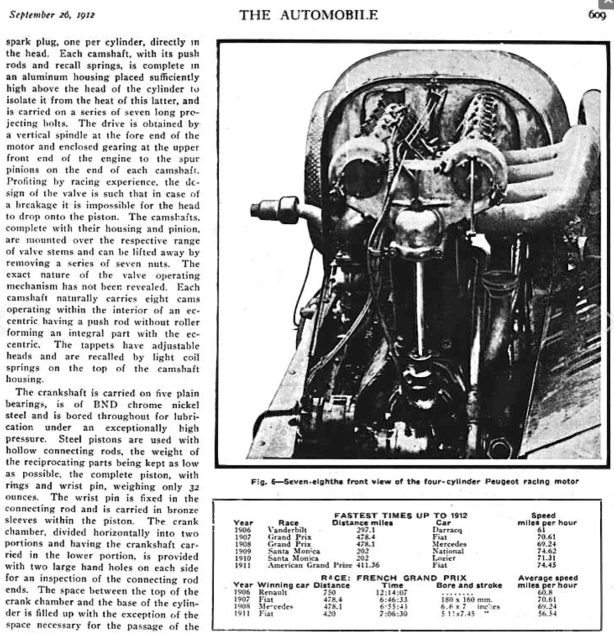


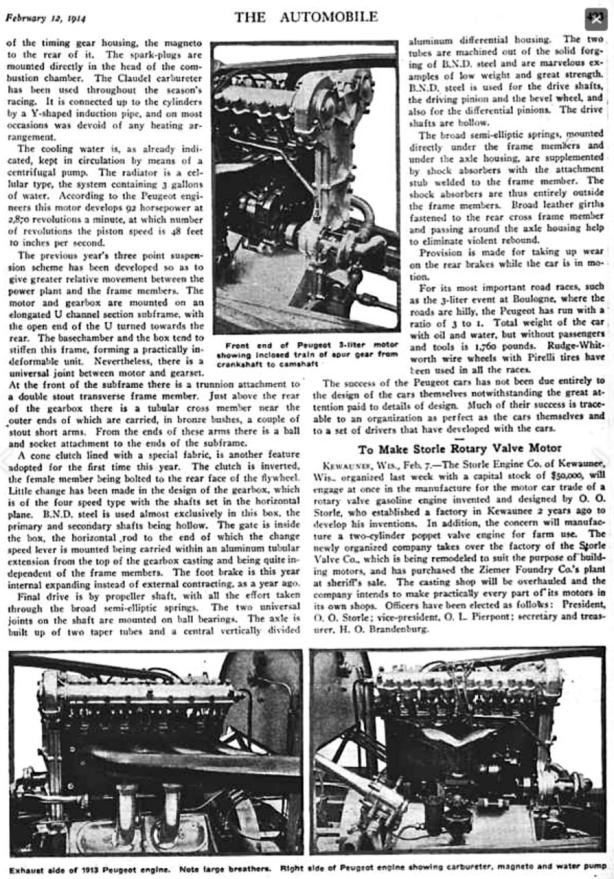
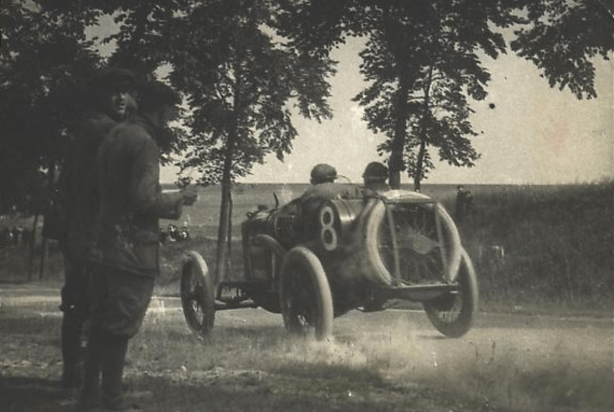
Really great stuff Mark. It is astounding how much of the basic engineering applied here is still applicable today. Limits have changed, as materials technology has progressed, but the laws of nature still apply to todays engines.
The 3 liter Peugeot had a counter balanced crank as well as the dry sump described, and its piston speed of around 15m/sec is similar to the Cosworth DFV in its early development. The steel pistons are little heavier than aluminium due to the thinner sections possible.
The inlet valve area, as was surprisingly common in the early days is too large, at around 0.55 of piston area. It was not until Fred Duesenberg put his mind to it in 1921, that it was discovered that a valve could be too large.
Right through the 1960s until the last 5 years, inlet valve area has been around .3 -.33 of piston area, latterly growing to 0.38.
Derek Taulbut has analysed and graphed many engineering relationships from 1906 through to current F1 engines, the results being astonishingly linear. Those engineers of yesteryear certainly got the most out of what they had, working within the constraints of materials, fuels, spark plugs, costs, lubricants and durability
Thanks Marcus, great to hear from a practicing engineer, I will do the occasional article on ‘the great engines’, equally I would value articles of that sort from you with an understanding I simply do not have! Mark
[…] https://primotipo.com/2015/12/11/191213-peugeot-gp-car-especially-its-engines/ […]
Bonsoir,
je suis passionné par La voiture des Charlatans , les pièces mécaniques étaient
en acier BND de chez DERIHON
je ne parle pas anglais , je mets juste deux liens
https://gallica.bnf.fr/ark:/12148/bpt6k4626311g/f2.item
http://cnum.cnam.fr/CGI/sresrech.cgi?P575.10/43
Thanks
Bonjour Didier,
heureux d’apporter les modifications, quels composants ont été fabriqués en acier BND/Derihon ?
Mark
Bonjour Mark
Dans la revue Omnia du 6 juillet 1912 il est écrit page 8 “le vilebrequin est en acier BND comme d’ailleurs toutes les pièces mécaniques du châssis”
https://gallica.bnf.fr/ark:/12148/bpt6k98059257/f9.item
Didier
Merci Didier,
j’ai modifié le texte par rapport au vilebrequin, mais j’ai complètement ignoré le châssis dans cette pièce, donc aucun amendement n’est nécessaire.
Merci d’avoir pris contact.
Cordialement, Mark
Bonjour Mark
C’est un plaisir de parler entre passionnés
Bonne journée
Didier
[…] this piece of mine about the engine, including period articles about the car; 1912/13 Peugeot GP Car: Especially its Engines… | primotipo… and this superb article by Pete Brock about how rapid Les Charlatans/Peugeot technology transfer to […]
Mark, I’ve been doing some research into these cars and could comfortably bore for England but I will endeavour to be brief.
A picture caption says that the 1913 Coupe de L’Auto was run concurrently with the Grand Prix. this was true in 1912 but not ’13; Georges Boillot won both races in different types of Peugeot.
A more substantial point concerns the Mundy drawing at the top of the article, said to be the 1913 Peugeot 3-litre, the L3. A similar drawing by L C Cresswell appears in Pomeroy’s THe Grand Prix Car, on page 166 of volume 2 in my edition. At that time neither Pomeroy nor Cresswell had seen an L3. In the 1950s (I think), Briggs Cunningham who owned an L3 had the engine stripped down and it was seen to have L-shaped tappets, nothing like the Cresswell and Mundy drawings. In the 1980s Griffith Borgeson attempted to find out what those drawings did represent. He documented his investigation and findings in Automobile Quarterly Vol 20 No3. He concluded that the drawings were of a 1914 GP Sunbeam.
It was well known that Louis Coatalen obtained an L3 Peugeot and got his Sunbeam design team to copy it for the 1914 racing cars. A key source in Borgeson’s research was Anthony Heal. Now Sunbeam built two types of racing car for 1914: a 3.3-litre for the TT and a 4.5-litre for the Grand Prix. In his great History of Sunbeam Racing Cars, Heal tells us that the TT cars had L-shaped tappets and the Grand Prix cars had finger tappets, similar to those in the Mundy and Cresswell drawings. So it seems that Cresswell and Pomeroy picked the wrong Sunbeam for the Peugeot drawing.
Just to complicate matters even further, Karl Ludvigsen’s Classic Racing engines has two drawings of the L3 engine. In one it has L-shaped tappets, in the other finger tappets. He says that the finger tappets was an alternative design by Ernest Henry.
Hi Roger,
Great to hear from you, and LOL in the World Bore Championship, rest assured I’m opening for Australia!
Man, what a detective story. The irony is that the inspiration for that article was seeing the cross section drawing in Automobile Year 10!
I’m on safari in Italy at present, heading to the UK next week. Are you London based? When I have the chance I’ll try to find another drawing, or otherwise re-write what is there to correct the errors.
Many thanks for letting me know.
Look forward to jumping back on our calls again soon.
Best regards,
Mark
Thanks Mark,
Fascinating story indeed and I suspect the L76 may be even more complicated but I haven’t got my head round that yet.
Unfortunately I live in the north of England, near Manchester. I believe you’re going to the Festival of Speed but I’ve had to Miss it for the first time in well over 20 years because of my back. It’s a lot better now but I don’t fancy walking round all day. I’m sure you’ll enjoy it!
I loved the picture of Bruce at Rouen.
Roger
>